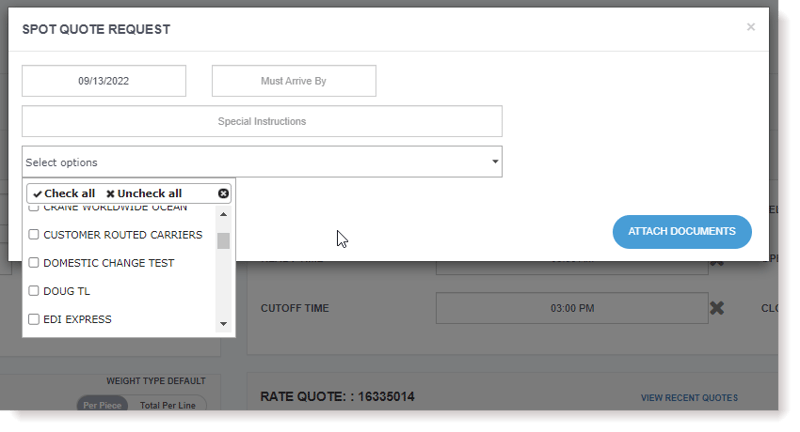6 min read
Beyond Spot Quoting: How a Modern TMS Revolutionizes Shipment Cost Management
By: FreightPOP on Apr 17, 2024

The logistics industry, vital for global commerce, has long been hampered by the cumbersome process of manual spot quoting—a method as outdated as it is inefficient. While this approach offers a rough estimate of shipping costs, it typically leads to shippers paying more than necessary. The traditional process of obtaining quotes is too slow, manual, and cumbersome, especially for shippers managing frequent freight shipments. Such shippers require a more streamlined and flexible solution, one that ensures they are getting the most competitive rates for their freight.
The Spot Quoting Process: How it Currently Works
To spot quote a freight shipment, shippers will typically need to do the following:
- Get in contact with a carrier.
- Communicate with the quotes department regarding shipment details (pallet count, weight, dims, shop to and from locations, etc.).
- The carrier will take the applicable shipment information and use it to generate a rate.
- The rate will be quoted and shared with the customer.
The Challenges of Manual Spot Quoting
The process described above is used to generate just one spot quote from a single carrier, showcasing significant inefficiencies. To get a quote, these four detailed steps must be completed, and this process must be repeated for each additional carrier the shipper wants to quote. This means obtaining a quote from one carrier can take hours, and getting quotes from multiple carriers to ensure competitive pricing can take days. This method is filled with inefficiencies and comes with several drawbacks:
- Time-Consuming Operations: Manual processing of each quote can take several hours or more, delaying decision-making and operational responsiveness.
- Prone to Errors: Human involvement in compiling and comparing quotes increases the likelihood of errors, potentially leading to incorrect and costly decisions.
- Lack of Real-Time Insights: Manual methods often rely on outdated information, leading to less optimal pricing and scheduling decisions.
- Scalability Constraints: As businesses grow, the volume of shipments increases. Manual quoting allows for virtually no scalability, so shippers who don’t adopt faster methods will just end up shipping with the first quote they get, overspending on freight shipping by potentially thousands of dollars per shipment.
Transformative Solution: Improve Freight Management with Automated Quoting
An advanced Transportation Management System (TMS) addresses these inefficiencies head-on by offering a robust, automated solution for obtaining shipment quotes:
- Single-Screen Accessibility: Modern TMS platforms enable users to automatically receive and compare quotes from hundreds of carriers across all modes of transportation—air, road, rail, and sea—on a single screen.
- Automated Processes: By automating the quote retrieval and comparison process, a TMS eliminates manual data entry, reducing time and error.
- Real-Time Data Integration: TMS solutions integrate with real-time data sources, providing up-to-the-minute quotes and enabling more accurate and timely decision-making.
- Enhanced Scalability: As the volume of shipments grows, a TMS effortlessly scales, maintaining efficiency without the need for proportional increases in labor.
Key Features of an Effective TMS
To fully leverage the benefits of a TMS, businesses should look for the following key features:
- Comprehensive Carrier Integration: A TMS should offer extensive connectivity options to hundreds and hundreds of carriers, ensuring broad market coverage and competitive rates in seconds.
- Mode Versatility: Effective TMS platforms handle multiple modes of transport, allowing seamless management of mixed-cargo shipments. Shipping parcel, LTL, FTL, Ocean or Air shouldn’t be a limiting factor in getting competitive quotes.
- Dynamic Routing and Rate Comparison: Advanced algorithms help identify the most cost-effective and efficient shipping routes and schedules, removing human error-prone processes.
- Analytics and Reporting Tools: Built-in analytics empower businesses to analyze shipping costs, identify trends, and make data-driven adjustments to their shipping strategies.
When Spot quoting is necessary
Unfortunately, some carriers are not technologically advanced enough to provide a way for TMSs like FreightPOP to automatically connect to their rates, and in these instances, the ability to spot quote when needed is still important. We built Spot Quote Groups just for this reason. Spot quote groups allow shippers to gather spot quotes on freight quickly and efficiently without having to contact each carrier individually via phone, email, or their website.
When you use FreightPOP's Spot Quote Groups, all eligible carriers for that shipment type receive the pickup and delivery schedule details. The carriers then respond with quotes, with all responses compiled in one place on your TMS. This makes it easy to compare rates and choose the best option for your needs.
Step 1 - Select Carriers:

Step 2 - Provide Details of Freight:

Step 3 - Compare Multiple Quotes Side-by-side

Not only is using Spot Quote Groups more efficient, but it also allows you to get the best possible rates for your shipments when API connections are not possible.
In either scenario, the transition from traditional, manual spot quoting to utilizing a sophisticated TMS can transform the landscape of logistics operations. By automating critical processes, providing real-time data, and ensuring scalability, a TMS not only enhances operational efficiency but also drives cost savings and improves service delivery across the board. As businesses continue to navigate a complex global market, the adoption of such technologies is no longer just an advantage—it's a necessity.
Related Posts
Shipping and Freight FAQs
Our goal is simple. We want to enable shippers to ship smarter, and ship easier. Please see our...
4 Ways Auditing Your Freight Saves You Money
Consistent shipping audits allow you to isolate inefficiencies, optimize your budget strategy, find...
New Tool For Spot Quoting Freight - Just In Time For The Holidays
Need to reduce freight costs? Spot Quote Groups are an essential tool for FTL/freight shipping. It...



